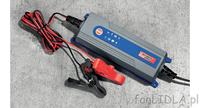Jolatta wrote: Hello
please help me in October 2012 I bought Ultimate Speed - Lidl, I had no need to recharge the battery. car but I checked and it was ok, that is, it showed what was below. In February 2013, I drove very little and the battery had to be charged. The replaced rectifier after switching on shows the car diode in red and the battery diode in green FULL. But I borrowed another rectifier from a friend and this one showed that you need to charge, so it loaded almost 11 hours. I connected it again with the lidl and it shows what was before and I am in a spot whether it is the rectifier's fault - whether it exchanges me or a refund. What should I motivate?
Thank you in advance for the answer
It is impossible to give a precise answer. On the one hand, it appears that the Lidl rectifier has detected that the battery is fully charged and has entered the "charged" mode, on the other hand, another rectifier recognized that it is not - which also does not mean anything (depends on the type of charger) .
However, maybe it was so that the battery really did not need to be charged - it was just charged (at least it had the correct voltage at its poles and the Lidl rectifier then realizes the state of charge).
Write down if the battery is working properly, i.e. if the car starts or if there are any problems. The fact that you have driven your car so little does not mean that the battery is dead. If you did not drive, for example, for 3 months, the battery would probably need charging. However, after a month or two-week break, probably not.
The test of the Lidl rectifier can be done like this: turn on the dipped headlights in the car (the engine is not working) for about 15 minutes. This will partially discharge the battery. Then connect the charger and turn on by. instructions. The charger should start working (2 red lights will be on). After charging, one of them will turn green (FULL) - then you will be sure that the Lidl rectifier is working. You can easily do this test yourself.
Greetings!




